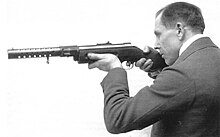Before and during World War II
Manufacturing regulations in the Treaty of Versailles (June 28, 1919) forbade Germany from developing heavy machine guns, but permitted machine pistols or submachine guns as a suitable weapon for police. This signaled the end of a 30-year cooperation between the Schmeissers and Bergmann as production was licensed to foreign weapons manufacturers. Schmeisser decided to continue work in weapons development. Together with his brother Hans Schmeisser, he created the "Industriewerk Auhammer Koch und Co" (Industrial Auhammer Koch and Company) in Suhl. Being at the end of World War I, he saw little business, and encumbered by the Treaty of Versailles, the future of the company was unclear. Schmeisser defied the treaty, working to continue development of automatic weapons. It was at this time that the company began cooperating with: C. G. Haenel Waffen- u. Fahrradfabrik Suhl (C.G. Haenel), beginning a 20-year partnership. For the safety of his patents, Schmeisser created a second company under the name of "Brothers Schmeisser" in the summer of 1922. This shrewd tactic was to prevent the loss of his patents if Auhammer went bankrupt. In order to prevent bankruptcy on both sides, Auhammer and Haenel merged, with Haenel taking full responsibility and liability for Auhammer business affairs. Schmeisser's attorneys who settled the deal became active shareholders in the company. Before long, it was obvious that development of many types of automatic weapons was unaffected or even accelerated by the Treaty of Versailles. In the 1920s Schmeisser developed the MP28, which was used extensively by the German police. Bayard signed an agreement with Schmeisser to manufacture and sell weapons to South Africa and Spain, among other countries. It is notable that these same weapons were used during the Spanish Civil War only 10 years later. Despite Schmeisser's success, the company often came within inches of bankruptcy.
As the Nazis rose to power during 1933, ten weapons development enterprises in Suhl and Zella-Mehlis merged under the name of "United Suhl-Zella Mehlis Armament Makers". This central administration was used to coordinate production with the army's needs, and it allowed Schmeisser to make a business acquaintance, which later developed to a friendship, with the aviator Ernst Udet, a deputy of Hermann Göring under Germany's Luftwaffe. Schmeisser had a direct role in military production decisions, often influencing the decisions of Adolf Hitler and Göring. After 1935 Haenel experienced an enormous upswing in weapon production. Against the desires of many engineers and technical designers, the Schmeisser brothers continued to enforce patent royalties and manage company funds.
Berthold Geipel of Erma designed the MP 36 using Vollmer's EMP. The chief designer, Heinrich Vollmer, revised the basic construction of Erma MP-36 and developed from it the well-known German submachine guns of the Second World War, the MP-38 and the MP-40. 1.2 million pieces were manufactured for these weapons, and were among the first weapons to be manufactured with die cast parts, metal stamping, and a complete machine-assembly. This method revolutionized weapon production, allowing manufacture at an unprecedented speed. They became internationally known as "Schmeisser MP"s, mainly due to the use of the straight magazine he had patented.
Schmeisser's most important work had been underway since 1938. This new automatic weapon, with a shortened 7.92 mm cartridge, allowed for smart usage of resources and high production. At first named the Mkb 42, it later received the designation of MP-43, and it became one of the first assault rifles. By 1943, 10,000 had been manufactured for the front. For a short time, Hitler stopped production, as he was mysteriously opposed to the new weapon. In 1944, after troop testing verified the new weapon's effectiveness, Hitler authorized mass production of the MP-43 as well as further research into a new MP-44. In April 1944 the new weapon received the designation of "Sturmgewehr 44" ("Assault Rifle 44"). The StG 44 was arguably Schmeisser's most important weapon development.
